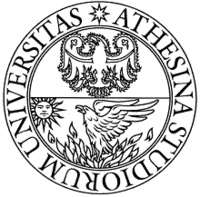About Bucharest
Bucharest, in Romanian București (the word stem "bucur" means "glad", "joy"; and its origin connects to a shepherd named Bucur that according to legends first established in this location) is the capital city, cultural, industrial, and financial centre of Romania. It is the largest city in Romania, located in the southeast of the country, and lies on the banks of the Dâmbovița River. Bucharest was first mentioned in documents as early as 1459. Since then, it has gone through a variety of changes, becoming the state capital of Romania in 1862 and steadily consolidating its position as the centre of the Romanian mass media, culture and arts. Its eclectic architecture is a mix of historical (neo-classical), interbellum (Bauhaus and Art Deco), communist-era and modern. In the period between the two World Wars, the city's elegant architecture and the sophistication of its elite earned Bucharest the nickname of the "Little Paris" (Micul Paris).
Adding the satellite towns around the urban area, the proposed metropolitan area of Bucharest has a population of 2.27 million people. Bucharest is the 6th largest city in the European Union by population within city limits, after London, Berlin, Madrid, Rome, and Paris.
Bucharest is one of the main educational and industrial centres and transportation hubs of Eastern Europe. There are 16 public universities and more than 19 private universities in Bucharest (with more than 159 different faculties) in all the areas of education, e.g., polytechnic, economics, medicine and pharmacy, human sciences and arts, etc.
Bucharest has a temperate-continental climate, with occasional excesses and differences in air temperature caused by the overheating of the city's streets. In the months of June to August the temperature climbs over 25°-30° Celsius (77°-86° Fahrenheit), while in winter it can drop to -10° Celsius (14° Fahrenheit). Elevation is 55-90m (190-295 feet).
Attractions
For complete information, please visit the official Bucharest tourism site.
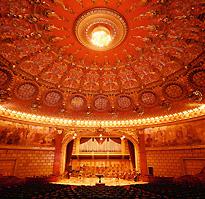
The Romanian Athenaeum (Ateneul Român): the work of French architect Albert Galleron, who also designed the National Bank of Romania, the Athenaeum was completed in 1888, financed almost entirely with money donated by the general public. One of the preeminent public fundraising campaigns ever in Romania, the "Give a penny for the Athenaeum" campaign saved the project after the original patrons ran out of funds. With its high dome and Doric columns, the Athenaeum resembles an ancient temple.

Parliament Palace (Palatul Parlamentului): built by the Communist Party leader, Nicolae Ceausescu, the colossal Parliament Palace (formerly known as the People's Palace) is the second largest administrative building in the world after the Pentagon. It took 20,000 workers and 700 architects to build. The palace boasts 12 stories, 1,100 rooms, a 328-feet-long lobby and four underground levels, including an enormous nuclear bunker. The Palace of Parliament it is the world's second-largest office building in surface (after the Pentagon) and the third largest in volume (after Cape Canaveral in the U.S. and the Great Pyramid in Egypt). Today, it houses Romania's Parliament and serves as an international conference centre. Built and furnished exclusively with Romanian materials, the building reflects the work of the country's best artisans. The interior is a luxurious display of crystal chandeliers, mosaics, oak panelling, marble, gold leaf, stained-glass windows and floors covered in rich carpets.
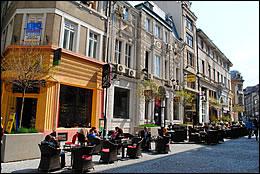
Old city center (Centrul vechi): Perhaps the city's unique charm can be best observed in the area known as Lipscani. At the beginning of 1400s, most merchants and craftsmen - Romanian, Austrian, Greek, Bulgarian, Serbian, Armenian and Jewish - established their stores and shops in this section of the city. Soon, the area became known as Lipscani, named for the many German traders from Lipsca or Leipzig. Other streets took on the names of various old craft communities and guilds, such as Blanari (furriers), Covaci (blacksmiths), Gabroveni (knife makers) and Cavafii Vechii (shoe-makers). The mix of nationalities and cultures is reflected in the mishmash of architectural styles, from baroque to neoclassical to art nouveau.
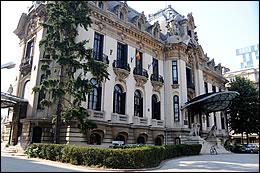
Victory Avenue (Calea Victoriei): is Bucharest's oldest and arguably, most charming street. Built in 1692 to link the Old Princely Court to Mogosoaia Palace, it was initially paved with oak beams. The street became Calea Victoriei in 1878, after the Romanian War of Independence victory. Between the two world wars, Calea Victoriei developed into one of the most fashionable streets in the city. Stroll along this street from Piata Victoriei to Piata Natiunilor Unite to discover some of the most stunning buildings in the city, including the Cantacuzino Palace, the historical Revolution Square, the Military Club, the CEC Headquarters and the National History Museum.
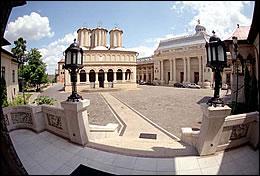
Metropolitan Church (Biserica Patriarhiei): set atop one of the city's few hills, known as Mitropoliei, the Metropolitan Church has been the centerpiece of the Romanian Orthodox faith since the 17th century. The church was built by Constantin Serban Basarab, ruler of the province of Walachia between 1656 and 1658, to a design inspired by the Curtea de Arges monastery. It became the Metropolitan Church in 1668 and the seat of the Romanian Orthodox Church in 1925. The Byzantine interior, containing the most dazzling of the city's iconostasis, as well as a couple of exquisitely carved side altars, bestows great beauty on the services presided over by the Romanian Patriarch.
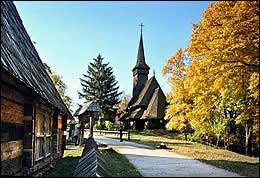
Village Museum (Muzeul Satului): founded by royal decree in 1936, this fascinating outdoor museum, the largest in Europe, covers some 30 acres on the shores of Lake Herastrau in Herestrau Park. It features a collection of 50 buildings representing the history and design of Romania's rural architecture. Steep-roofed peasant homes, thatched barns, log cabins, churches and watermills from all regions of the country were carefully taken apart, shipped to the museum and rebuilt in order to recreate the village setting. Throughout the year, the Village Museum hosts special events where you will have a chance to witness folk artisans demonstrating traditional skills in weaving, pottery and other crafts. Folk arts and crafts are available at the museum gift shop.
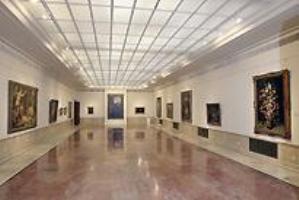
Art Museum (Muzeul Național de Artă): Romania's leading art museum was founded in 1948 to house the former Royal Collection, which included Romanian and European art dating from the 15th to the 20th century. Located in the neoclassical former Royal Palace, set amid a wealth of historic buildings such as the Romanian Athenaeum, Kretzulescu Church and the Hotel Athenee Palace-Hilton, the museum currently exhibits over 100,000 works divided into two major sections. Its National Gallery features the works of major Romanian artists, including Grigorescu, Aman and Andreescu. There is also a roomful of early Brancusi sculptures, such as you will not find anywhere else, demonstrating how he left his master, Rodin, behind in a more advanced form of expression. The European Gallery, comprising some 15 rooms, displays little-known art gems from the likes of El Greco, Monet, Rembrandt, Renoir, Breughels (father and son) Cezanne and Rubens. If you only have time to visit one gallery, make it the Romanian one. It is the most complete collection of Romanian works of art in the country and quite possibly, the world.
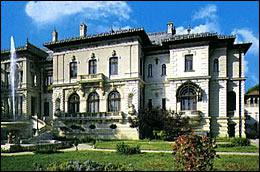
Cotroceni Palace and Museum (Muzeul Național Cotroceni): a former royal residence built between 1679 and 1681 by Prince and ruler Serban Cantacuzino, the palace was home to King Carol I, who made important changes in its architecture. At the end of the 19th century, Heir-to-the-Crown Ferdinand ordered the partial demolition of the palace, which was later reconstructed by French architect Paul Gottereau in a neoclassical style. In 1977, Nicolae Ceausescu transformed it into an official guesthouse with the addition of a new wing. After 1990, the old wing of the palace became a museum. The Oriental Hall, the Norwegian Hall and the Queen's Chamber are almost unchanged from the original design and are worth visiting. A very important collection of medieval art also can be seen here. The new wing serves as the seat of the Romanian Presidency. Across the palace you can visit the Botanical Garden. Opened in 1891, the garden features over 5,000 varieties of plants from Romania and around the world. The garden also encompasses a beautiful building in the Brancovenesc architectural style, housing the Botanical Garden Museum.

Cișmigiu Garden (Grădina Cișmigiu): designed in 1845 by the German landscape architect Carl Meyer, the garden opened to the public in 1860. The name, Cișmigiu, comes from the Turkish cismea, meaning "public fountain." More than 30,000 trees and plants were brought from the Romanian mountains, while exotic plants were imported from the botanical gardens in Vienna. Cișmigiu is Bucharest's oldest park and a great place to stroll and enjoy a break from the hectic city.
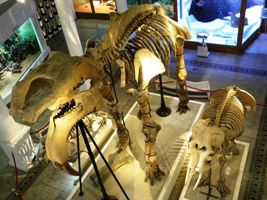
“Grigore Antipa” National Museum of Natural History is one of the oldest research institutions in the field of biodiversity and public education. It is in the same time one of the well known and highly appreciated “databases” due to the Museum’s collections, some of them valuable assets of the worldwide thesaurus: mineralogical, zoological and paleontological collections. The Grigore Antipa National Museum of Natural History bears the name of Grigore Antipa, the most famous Romanian biologist the achievements of which have hardly been matched by any of his fellow Romanian specialized in the field (Grigore Antipa was, amongst others, the first Romanian who reached the North Pole).
Food and drinks
Romanian cuisine is a diverse blend of different dishes from several traditions with which it has come into contact, but it also maintains its own character. It has been greatly influenced by Ottoman cuisine, while it also includes influences from the cuisines of other neighbours, such as Germans, Serbs, Bulgarians and Hungarians. In Bucharest there are plenty of eateries where a foreigner’s culinary curiosity can be rewardingly satisfied. On top of the traditional delights one can indulge in trying many things. Tourists, if not in the mood for gastronomic experiments, might just as well confine to the routine of their daily culinary preferences, since the city is full with restaurants where the international cuisine is duly honoured, with an emphasis on the French, Italian, Chinese, Indian and American specialties.
Traditional dishes (include)
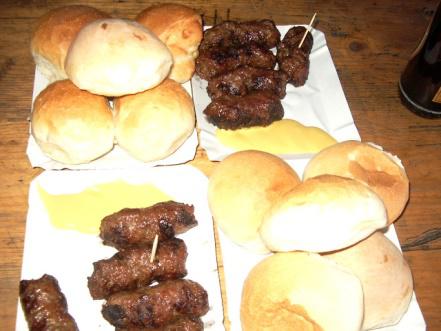
Mititei are made of a mix of minced pork, beef and lamb. Mititei are the favourite grilled rolls of the Romanian people. Tourists can easily notice the popularity of this dish while strolling around in Bucharest, since ranging from low-key eateries, stalls in the open-air markets to the upmarket restaurants of Bucharest, all the eating venues feature mititei on their menus. Tochitură is, perhaps, one of the most outrageous Romanian specialties, at least from the point of view of a faddy nutritionist. It consists of the meat of a freshly slaughtered pig (occasionally, sundried organs can also be added), fried in a pan in the pig’s own fat. It is often eaten with fried eggs, grated telemea (salted cheese), fried sausages and mămăligă (polenta). Pickles are strongly recommended.

Sarmale are stuffed cabbage rolls. The filling consists of forcemeat (though vegetarian sarmale are an option too), and instead of cabbage for the rolls, one can always use grapevine leaves or even dock leaves. In order to eat sarmale by the book, tourists are advised to order mămăligă (polenta) and cream.
Ardei umpluţi, the stuffed bell peppers are very similar to sarmale, meaning the filling is approximately the same. The only difference refers to the wrap: instead of cabbage, we speak of bell peppers.
Zacuscă is a mix of eggplant, zucchini, onion, tomatoes, mushrooms and bell peppers. It is usually consumed spread on bead loaves, and it is a relief for vegetarians who look for an option into the secrets of the Romanian cuisine. Zacuscă can be eaten fresh, right after cooking, or it can be canned and eaten virtually all the year round.
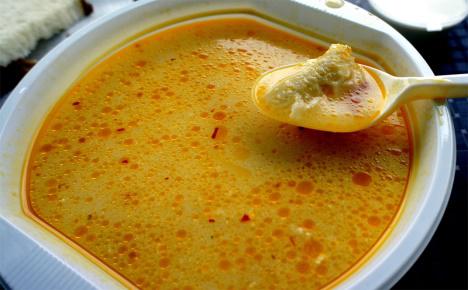
Ciorbă is a general term which covers a large range of soups soured with lemon juice, vinegar or, more commonly, borsch (borş in Romanian). Most often, ciorbă contains a mix of vegetables (potatoes, tomatoes, carrots, onions, celery, peppers) and herbs, and, depending on what kind of ciorbă we speak of, it also contains beans, meat (pork, chicken or beef), fish, rice, and the so-called tăieţei (a sort of traditional pasta made of heavy dough). Ciorba de burtă (tripe soup) is, though pretty different in cooking from the general recipe described above, one of the locals’ favourites. It is served with garlic sauce, cream and vinegar.
Răcitură (piftie) is prepared as a rule during the winter holiday season. It can be made of fish, chicken, or beef but more commonly of pork, and seasoned with vegetables and heavily spiced with garlic. The meat is boiled in water, and the produce is left to jollify while kept at a low temperature.
Deserts (include)
Papanași is a Romanian traditional fried or boiled pastry resembling a small sphere, usually filled with a soft cheese such as urdă and any kind of sour jam. The word papanași may come from the Latin papa or pappa, which means "food for children".
Şarlotă, a custard made with milk, eggs, sugar, whipped cream, gelatin, fruits, and lady fingers; from the French Charlotte.
Cozonac, a traditional sweet bread, similar to Italian panettone, that is usually prepared for every major holiday (Christmas, Easter, New Year, Pentecost) in Romania. Depending on the region, one may add to it any of the following: raisins, lokum, grated orange or lemon rind, walnuts or hazelnuts, vanilla or rum flavour. Cozonac may be sprinkled with poppy seeds on top. Other styles use a filling, usually a ground walnut mix, ground poppy seeds mixture, cocoa powder, rum essence and raisins.
Plăcintă is a Romanian traditional pastry resembling a thin, small round or square-shaped cake, usually filled with a soft cheese such as urdă or apples.
Traditional beverages (include):
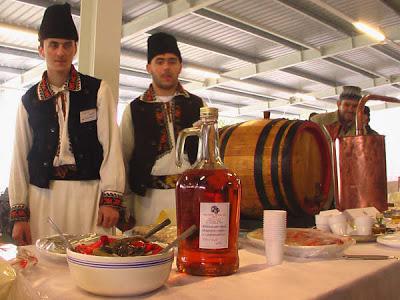
Vin (wine): Romania is a major wine producer. Either red or white, the Romanian wines can very well accompany a hearty meal at one of the chic restaurants of Bucharest. The so-called Fetească, Tămâioasă and Grasă are the most advisable. However, the best eateries of Bucharest always welcome clients with fine selections of internationally reputed wines.
Ţuică is best defined as a plum brandy traditionally produced in Romania for centuries. It is a liquor largely consumed by the locals who, apparently, have developed a bewildering tolerance to the high alcohol concentration of this beverage. Foreigners, however, are advised to drink in moderation. Regional versions of ţuica refer to palincă (in Transylvania), rachiu, şliboviţă and secărică. Vişinata is yet another alcoholic specialty, made of rachiu, cherries and sugar. The homemade vişinata guarantees the authenticity of the traditional recipe.
Bere (beer): there are several Romanian beer brands curious tourists can try out. Reputed national brands refer to Ursus, Timişoreana, Silva and Bergenbeer, just to list a few. However, while exploring the scene of the local restaurants and bars, visitors should definitely check out the home-brewed beers of the respective venues.
Restaurants
There is no shortage of eateries in Bucharest. Ranging from low-key eating venues to stylish restaurants, the eating venues in the capital of Romania cater for all sorts of culinary demands. Thus, may it be international specialties or Romanian traditional dishes, the restaurants, bistros, cafes, pizzerias and food stalls in Bucharest are up to satisfying all palates and pockets.
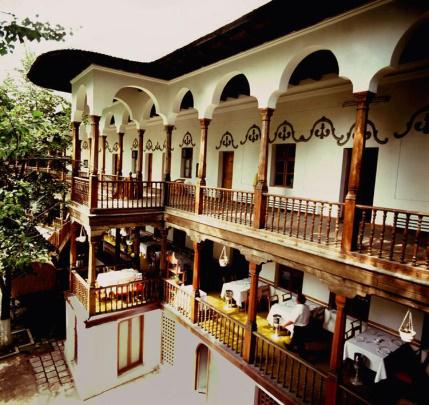
Hanul Lui Manuc, built in 1808 as a hotel by the Armenian entrepreneur Manuc Bei, Hanul Lui Manuc is suffused with history. In 2006, the building was acquired by current owner Constantin Şerban Cantacuzino. In 2007, its doors were closed for a major renovation, only to reopen in June 2011. Hanul Lui Manuc is divided into two parts, one Lebanese, one Romanian. Both the Romanian and Lebanese menus showcase diverse examples from the respective cuisines. Interesting fact: Hanul Lui Manuc is the oldest hotel and restaurant in Bucharest. Website: http://www.hanulluimanuc.ro/
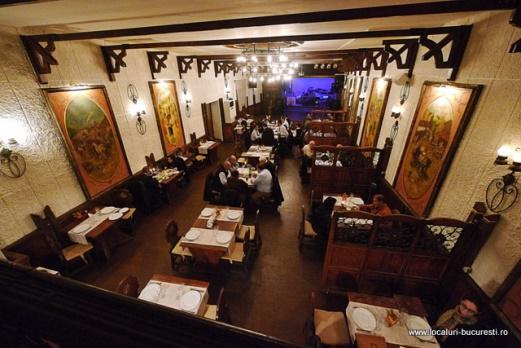
Terasa Doamnei: situated in the historic center of Bucharest, on Doamnei Street, the restaurant Terasa Doamnei is a place that cannot be passed by unnoticed. It invites guests to enjoy, in an intimate and quiet setting, the exquisite dishes of Romanian and international cuisine in the magnificent atmosphere of Balkanic music. Website: http://www.terasadoamnei.ro/
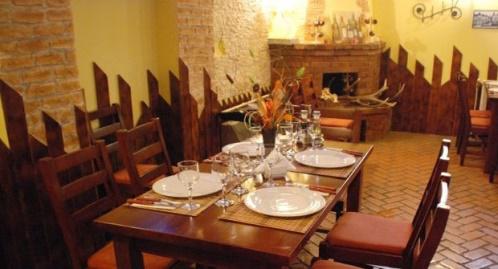
Casa Jienilor, proposes food that is specific to different country zones, e.g., Maramureș, Moldova, Muntenia, Dobrogea. Zone specific costumes, decorations, folk music bands and drinks are also available. Website: http://www.casajienilor.ro/
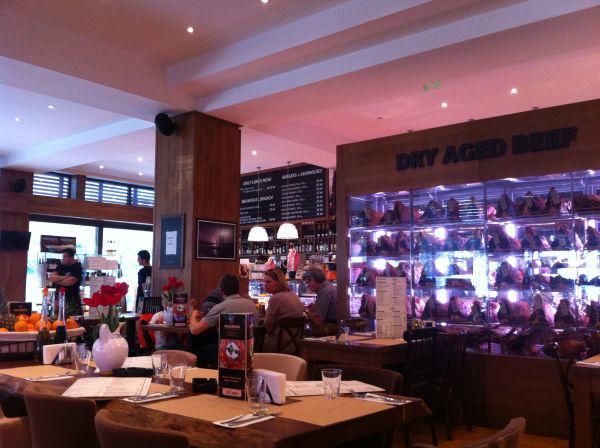
Vacamuuu: watch out vegetarians, this is Bucharest’s foremost meat eatery, and the city’s most famous steakhouse. It would be hard to find another place that serves a wider variety of steaks. The mouth-watering selection of aged beef specials or steak sandwiches makes this the right spot for the hungry carnivore. In addition to the restaurant section, Vacamuuu is also home to a marketplace, where high-quality products such as salami and cheese are sold. Website: http://www.vacamuuu.com/
The Caru' cu Bere (aka "Carul cu Bere" - the beer wagon) is a bar and restaurant on Stavropoleos Street in the Lipscani district of Bucharest, Romania, opened in 1879 and moved to the current location, a gothic revival building designed by Austrian architect Siegfrid Kofczinsky, in 1899. It is noted for its interior decoration, in art nouveau style. Website: https://www.carucubere.ro/en/
Sightseeing

There are a number of sightseeing visits that can be organized from Bucharest. The most appealing is the city tour on double-decker buses. Travellers can get an introduction to Bucharest's fascinating architectural mix and get familiar with the city's central neighbourhoods and places of interest in less than one hour. Sights and major attractions include: Village Museum (Muzeul Satului), Arch of Triumph (Arcul de Triumf), Natural History Museum (Muzeul Antipa), Geology Museum (Muzeul de Geologie), Museum of the Romanian Peasant (Muzeul Țăranului Român), Headquarters of the Romanian Government (Palatul Victoria), The Romanian Athenaeum (Ateneul Român), National Museum of Art (Muzeul Național de Artă), Church Cretulescu (Biserica Crețulescu), The Savings Bank (Palatul CEC), National History Museum (Muzeul Național de Istorie), Parliament's Palace (Palatul Parlamentului), Romanian Patriarchy (Patriarhia Română), Manuc's Inn (Hanul lui Manuc), Bucharest University (Universitatea), Museum of the City of Bucharest (Muzeul Municipiului București), National Theatre (Teatrul Național), Academy of Economic Studies (Academia de Studii Economice). Day bus ticket (card) cost 25 lei (~6 Eur). Website: http://www.bucharestcitytour.ro/
Bucharest is a great starting point from which to explore the rest of the country. Away from the buzz of the city, you will find a different side of Romania - life in the countryside moves more slowly, the air is crisp and hospitality abounds. Here are some Bucharest day-trips ideas:
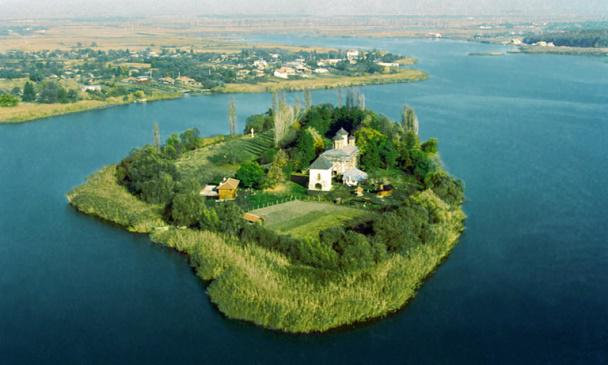
Snagov Lake and Snagov Monastery (38 Km - 24 Miles North of Bucharest), location: Snagov. In 1458 - more than one hundred years after the church was built (1364) - Romanian prince Vlad Țepeș (Vlad the Impaler - Dracula) added thick defending walls and a dungeon. A plaque on the floor inside the church marks the grave with the presumed remains of the world-known count. The monastery is located on an island on lake Snagov, and can be accessed on a pedestrian bridge or by boat. Website: http://www.snagov.ro/
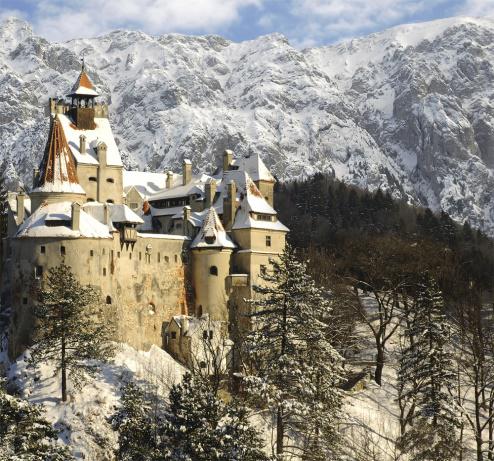
Bran Castle (172 Km - 107 Miles South of Bucharest), location: Transylvania – Central Romania, Surrounded by an aura of mystery and legend and perched high atop a 200-feet-high rock, Bran Castle owes its fame to its imposing towers and turrets as well as to the myth created around Bram Stocker’s Dracula. Built on the site of a Teutonic Knights stronghold dating from 1212, the castle was first documented in an act issued by Louis I of Hungary on November 19, 1377, giving the Saxons of Kronstadt (Brasov) the privilege to build the Citadel. Website: http://www.Bran-Castle.com/
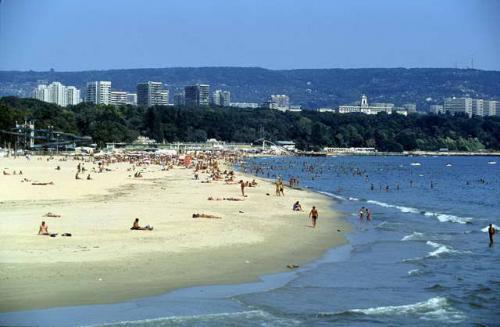
Black Sea Resorts (207 Km - 129 Miles from Bucharest), location: Constanța. Warm climate, miles of sand beaches, ancient monuments, vineyards and modern resorts invite travellers to seriously consider Romania's Black Sea Coast as their summer vacation destination. Beaches, stretching from Mangalia to Mamaia, are dotted with fine resorts and hotels, and countless sports and entertainment facilities. Remnants of ancient Greek culture as far back as the 7th Century, BC, when seafarers established trading colonies along the coast, are still being discovered. Romania's main sea resorts are centred on 72 Km - 45 Miles of fine sand beaches and include Mamaia, Eforie, Neptun, Jupiter, Venus, Saturn and Mangalia.
Other resources
There are just too many interesting things and places to see and try in Bucharest to fit in just one list. Therefore we recommend the following sites as search base for additional information:



